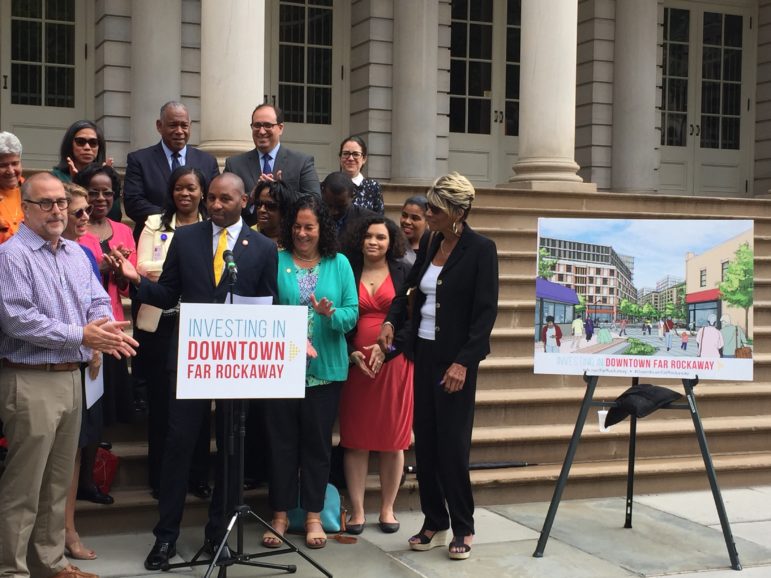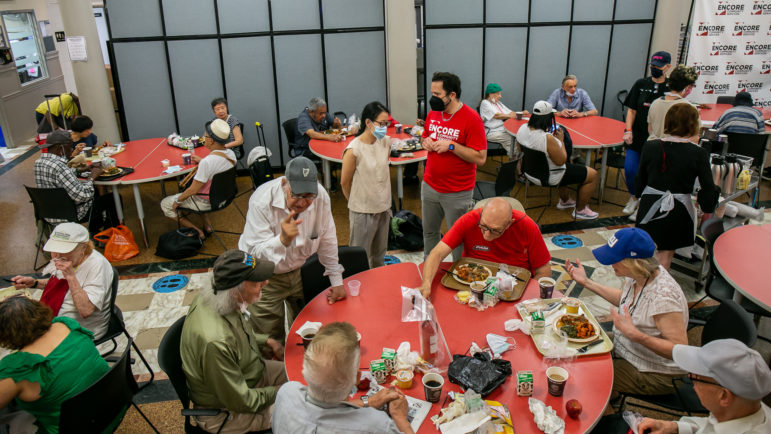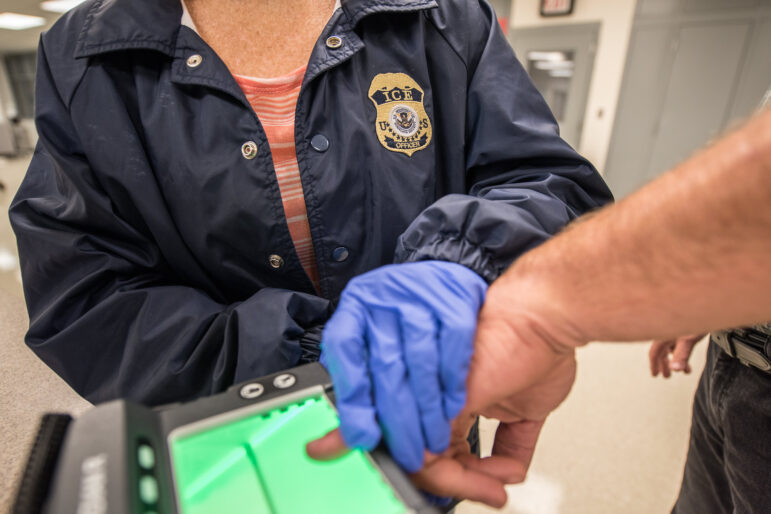
Abigail Savitch-Lew
Richards, electeds, De Blasio administration officials and community advocates gather on the steps of City Hall to celebrate the passage of the Downtown Far Rockaway rezoning.
On Thursday afternoon, the City Council approved a modified version of the de Blasio administration’s proposed rezoning of downtown Far Rockaway, making it the second of the mayor’s neighborhood rezoning plans to become law. At least eight other rezoning proposals are currently in other stages of review and study.
The rezoning increases the allowable heights of buildings in the downtown area, allows the development of affordable housing on one public lot, and also facilitates the complete redevelopment of several parcels of land at downtown’s center. Altogether, the plan is expected to create more than 3,100 units of new housing, as well as new commercial and community facility space and a new park.
The parcels in downtown’s center, many of which are owned by the estate of the late property owner Rita Stark and have long been left abandoned, have been now designated an Urban Renewal Area and will be rebuilt with a new street grid and new housing, retail, and community facilities. In August, the city announced it would aim to make the 1,700 units of housing projected to be built in that area all affordable, though that could not be entirely guaranteed because the ownership of the parcels is still under negotiation, as City Limits reported.
Compared to the East New York rezoning, which most people agree was an idea hatched by the Department of City Planning, the Downtown Far Rockaway rezoning is more homegrown: It was initiated in response to a letter sent by local councilmember Donovan Richards and a working group that sought to revitalize Far Rockaway’s desolate downtown.
The group felt the city’s plan in many ways answered their call, but also negotiated for a variety of changes and additional investments, which are described here. Altogether, the plan will come with $288 million in investments, including federal, city and private funding and recent, earlier-announced investments. That said, there are some community members who are still skeptical about the plan and disappointed that more changes were not made.
Prior to the Thursday vote, Richards, de Blasio administration officials, State Assemblywoman Stacey Pheffer Amato and community advocates gathered on the steps of City Hall to celebrate the rezoning’s passage, with Richards stressing that after “40 years of false starts” the community would finally benefit from a variety of investments in commercial revitalization, job creation, open space, youth programming and more. He stressed that those who survived the tough times would be able to stay because of the affordable housing comment.
“We heard you loud and clear, and all the things you spoke of and dreamed of for this community did not fall on deaf ears,” he said, and he thanked Deputy Mayor Alicia Glen, saying she “puts her money where her mouth is.”
Glen praised Richards not only for the Far Rockaway rezoning, but also for his work as zoning committee chair shepherding through a variety of other de Blasio administration initiatives this summer, including the rezoning of Midtown East to produce more office space and the approval of Avalon Bay’s partially affordable tower and school complex. She heralded what she described as “the beginning of what it will mean to have truly mixed-use, mixed-income neighborhoods all over the city.”
There were even warm congratulatory words from Jonathan Gaska, the district manager of Community Board 14, which has some frustrations with the final plan. Richards did not honor the board’s request to reduce the city’s proposed housing density or add more parking.
“We didn’t agree on everything, but we agreed to disagree,” Gaska said, and he praised the plan as a “great deal for Far Rockaway” and said it would “create jobs that we need sorely in the Rockaways.”
Kevin Alexander, CEO of the Rockaway Redevelopment and Revitalization Corporation and a key member of the original working group that called for the city’s attention, was also effusive. He told City Limits after the press conference that the plan does a good job in investing in the vocational education and skill-building of the area’s existing residents. His only concern is he’s still unsure whether the plan has reached the “sweet spot” between preserving Far Rockaway’s “village feel” and allowing enough development to facilitate commercial development, but is optimistic there might still be opportunities to negotiate down the number of units if it feels like too much housing.
But Eugene Falik, a staunch opponent who says Far Rockaway has enough subsidized housing, called City Limits in August to express his frustration that the city, which has long said it would aim to make at least 50 percent of the Urban Renewal Area affordable, had announced the goal to make 100 percent affordable. He’s concerned residents of affordable housing will not be able to sustain economic revitalization in the area.
The community board asked for 60 percent of the housing to be affordable—more than the city was proposing at the time—though it’s unclear whether they originally meant in the Urban Renewal Area or in the rezoning as a whole. Gaska told City Limits Thursday the board would ideally still like to see some market-rate housing in the Urban Renewal Area.
Spokespersons for the city and Richards said there was no attempt to hoodwink the community; they said “at least 50 percent” because negotiations about term sheets and ownerships have been ongoing, though it was always Richards’ intention to create 100 percent affordable housing in the URA. And Alexander, who closely monitors the neighborhood’s business corridors, said he was not concerned it was too much affordable housing and that it was crucial to helping low-income residents and give public housing residents an opportunity to move to someplace new.
Alexis Smallwood, a community activist who also came to celebrate the plan, scoffed at the suggestion that lower-income people could not support a thriving neighborhood with thriving commerce. In contrast, her worries are more about gentrification: Based on her experience being priced out of Harlem, and of what she described as rent increases and poor conditions at another affordable development in the Rockaways, she is worried that the “affordable housing” in the plan might not actually end up being so affordable to residents or may be of poor quality.
She also wants to see a diversity of people on the steering committee—not just Richards’ strong supporters—on the steering committee that will oversee the progress of the rezoning plan.
Just who will be on this steering committee will be interesting in another sense: Will it include residents from the wealthier, whiter parts of the Island to the west or just residents of the Downtown Far Rockaway community? Richards office says it hasn’t begun planning the make-up and structure of the committee.
In addition to the vote on the Far Rockaway rezoning, the Council approved two 100 percent income-restricted developments in Brooklyn. The Council also approved the Department of Sanitation’s plan to relocate its garage on East 99th Street to a site on East 127th Street. Due to the strong community opposition to the relocation site, the Council added a clause that said the East 127th Street site would be a temporary location while the Department of Sanitation crafts a plan to build a new permanent facility for the district.
In addition, the city’s proposal to redevelop the East 126th Street Bus Depot in East Harlem with an African Burial Ground memorial is making progress: the Council and de Blasio administration have agreed to ensure 80 percent of the housing is affordable. (EDC had previously said at least 50 percent would be affordable, provoking community concerns about luxury development at the site.) The final vote will take place on September 27.
According to the de Blasio administration, since the City Council approved mandatory inclusionary housing last year, it has signed off on 10,200 units of housing, of which 7,500 are rent-restricted for specific incomes, including 2,600 that will be permanently rent-restricted, not including additional affordable housing that will be created through rezonings in individual projects not yet approved.
“Permanently affordable housing won’t just be an aspiration in these neighborhoods—it will be a reality,” said de Blasio in a statement sent to City Limits on Thursday. “These projects are blueprints for increasing the vitality and diversity that make New York great. This city has always been for everyone, and these ensure it stays that way for generations to come.”









One thought on “City Council Approves De Blasio’s 2nd Neighborhood Rezoning”
God the city zoning laws are such a nightmare. We have a housing crisis! I’d love to see all density restrictions removed from residential zones. As it is there’s so little land to build on that when developers do manage to get some all they want to put are luxury condos. We should be in a crazy housing building boom to keep up with demand, and instead we’re not because it’s illegal.